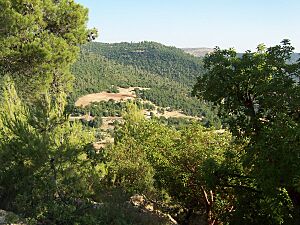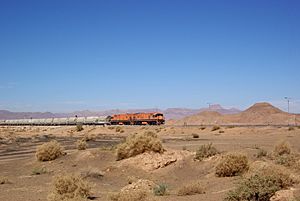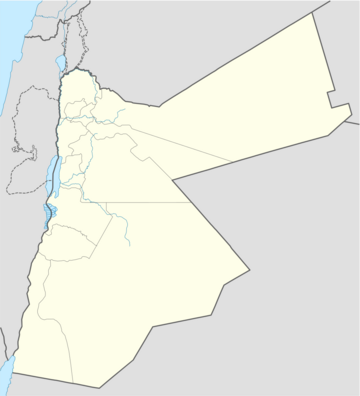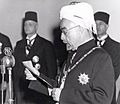Jordan facts for kids
Quick facts for kids
Hashemite Kingdom of Jordan
|
|
|---|---|
|
|
|
|
Motto: الله، الوطن، الملك
Allāh, al-Waṭan, al-Malik "God, Country, King" |
|
|
Anthem: السلام الملكي الأردني
Al-Salām al-Malakī al-Urdunī "The Royal Anthem of Jordan" |
|
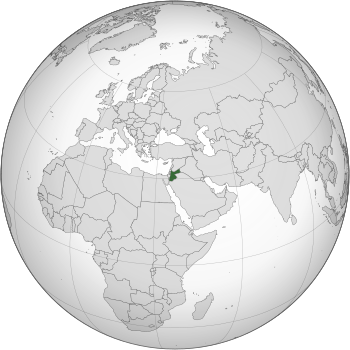 |
|
| Capital and largest city
|
Amman 31°57′N 35°56′E / 31.950°N 35.933°E |
| Official languages | Arabic |
| Ethnic groups |
|
| Religion | 1% others |
| Demonym(s) | Jordanian |
| Government | Unitary parliamentary constitutional monarchy |
|
• Monarch
|
Abdullah II |
| Jafar Hassan | |
| Legislature | Parliament |
| Senate | |
| House of Representatives | |
| Independence
from the United Kingdom
|
|
|
• Emirate
|
11 April 1921 |
| 25 May 1946 | |
|
• Current constitution
|
11 January 1952 |
| Area | |
|
• Total
|
89,342 km2 (34,495 sq mi) (110th) |
|
• Water (%)
|
0.6 |
| Population | |
|
• 2023 estimate
|
11,484,805 (84th) |
|
• 2015 census
|
9,531,712 |
|
• Density
|
114/km2 (295.3/sq mi) (70th) |
| GDP (PPP) | 2023 estimate |
|
• Total
|
|
|
• Per capita
|
|
| GDP (nominal) | 2023 estimate |
|
• Total
|
|
|
• Per capita
|
|
| Gini (2011) | 35.4 medium |
| HDI (2022) | high · 99th |
| Currency | Jordanian dinar (JOD) |
| Time zone | UTC+3 |
| Driving side | right |
| Calling code | +962 |
| ISO 3166 code | JO |
| Internet TLD | .jo .الاردن |
|
Website
jordan.gov.jo |
|
Jordan, officially the Hashemite Kingdom of Jordan, is a sovereign Arab state in Western Asia, on the East Bank of the Jordan River. Jordan is bordered by Saudi Arabia to the south, Iraq to the north-east, Syria to the north, Israel and Palestine to the west. The Dead Sea lies along its western borders and the country has a small shoreline on the Red Sea in its extreme south-west, but is otherwise landlocked. Jordan is strategically located at the crossroads of Asia, Africa and Europe. The capital, Amman, is Jordan's most populous city as well as the country's economic, political and cultural centre.
What is now Jordan has been inhabited by humans since the Paleolithic period. Three stable kingdoms emerged there at the end of the Bronze Age: Ammon, Moab and Edom. Later rulers include the Nabataean Kingdom, the Roman Empire, and the Ottoman Empire. After the Great Arab Revolt against the Ottomans in 1916 during World War I, the Ottoman Empire was partitioned by Britain and France.
The Emirate of Transjordan was established in 1921 by the Hashemite, then Emir, Abdullah I, and the emirate became a British protectorate. In 1946, Jordan became an independent state officially known as the Hashemite Kingdom of Transjordan, but was renamed in 1949 to the Hashemite Kingdom of Jordan.
Jordan is a relatively-small, semi-arid, almost-landlocked country with an area of 89,342 km2 (34,495 sq mi) and a population numbering 10 million, making it the 11th-most populous Arab country. Sunni Islam, practiced by around 95% of the population, is the dominant religion in Jordan that coexists with an indigenous Christian minority. Jordan has been repeatedly referred to as an "oasis of stability" in a turbulent region.
It has been mostly untouched from the violence that swept the region following the Arab Spring in 2010. From as early as 1948, Jordan has accepted refugees from multiple neighbouring countries in conflict. An estimated 2.1 million Palestinian and 1.4 million Syrian refugees are present in Jordan as of a 2015 census. The kingdom is also a refuge to thousands of Iraqi Christians fleeing persecution by ISIL. While Jordan continues to accept refugees, the recent large influx from Syria placed substantial strain on national resources and infrastructure.
Jordan is classified as a country of "high human development" with an "upper middle income" economy. The Jordanian economy, one of the smallest economies in the region, is attractive to foreign investors based upon a skilled workforce. The country is a major tourist destination, also attracting medical tourism due to its well developed health sector. Nonetheless, a lack of natural resources, large flow of refugees and regional turmoil have hampered economic growth.
Jordan is a constitutional monarchy and has a king. The King is the head of state, but he does not have all the power in the country. King Abdullah II has been the King of Jordan since February 1999. Most Jordanians are Muslim. There are around 200-400 000 Christians.
Contents
Geography

Jordan sits strategically at the crossroads of the continents of Asia, Africa and Europe, in the Levant area of the Fertile Crescent, a cradle of civilization. Its area is 89,341 square kilometres (34,495 sq mi), and it is 400 kilometres (250 mi) long between its northernmost and southernmost points; Umm Qais and Aqaba respectively. The kingdom lies between 29° and 34° N, and 34° and 40° E. It is bordered by Saudi Arabia to the south and the east, Iraq to the north-east, Syria to the north, and Israel and Palestine (West Bank) to the west.
The east is an arid plateau irrigated by oases and seasonal streams. Major cities are overwhelmingly located on the north-western part of the kingdom with its fertile soils and relatively abundant rainfall. These include Irbid, Jerash and Zarqa in the northwest, the capital Amman and As-Salt in the central west, and Madaba, Al-Karak and Aqaba in the southwest. Major towns in the east are the oasis towns of Azraq and Ruwaished.
In the west, a highland area of arable land and Mediterranean evergreen forestry drops suddenly into the Jordan Rift Valley. The rift valley contains the Jordan River and the Dead Sea, which separates Jordan from Israel. Jordan has a 26 kilometres (16 mi) shoreline on the Gulf of Aqaba in the Red Sea but is otherwise landlocked. The Yarmuk River, an eastern tributary of the Jordan, forms part of the boundary between Jordan and Syria (including the Israeli-occupied Golan Heights) to the north. The other boundaries are formed by several international and local agreements and do not follow well-defined natural features. The highest point is Jabal Umm al Dami, at 1,854 m (6,083 ft) above sea level, while the lowest is the Dead Sea −420 m (−1,378 ft), the lowest land point on Earth.
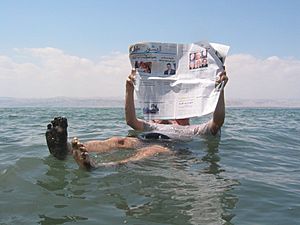
Jordan has a diverse range of habitats, ecosystems and biota because of its varied landscapes and environments. The Royal Society for the Conservation of Nature was set up in 1966 to protect and manage Jordan's natural resources. Nature reserves in Jordan include the Dana Biosphere Reserve, the Azraq Wetland Reserve, the Shaumari Wildlife Reserve and the Mujib Nature Reserve.
Climate
The climate varies greatly; generally, the further inland from the Mediterranean, there are greater contrasts in temperature and less rainfall. The average elevation is 812 m (2,664 ft) above sea level. The highlands above the Jordan Valley, mountains of the Dead Sea and Wadi Araba and as far south as Ras Al-Naqab are dominated by a Mediterranean climate, while the eastern and northeastern areas of the country are arid desert. Although the deserts reach high temperatures, the heat is usually moderated by low humidity and a daytime breeze, while the nights are cool.
Summers, lasting from May to September, are hot and dry, with temperatures averaging around 32 °C (90 °F) and sometimes exceeding 40 °C (104 °F) between July and August. The winter, lasting from November to March, is relatively cool, with temperatures averaging around 11.08 °C (52 °F). Winter also sees frequent showers and occasional snowfall in some western elevated areas.
Biodiversity
Over 2,000 plant species have been recorded. Many of the flowering plants bloom in the spring after the winter rains and the type of vegetation depends largely on the levels of precipitation. The mountainous regions in the northwest are clothed in forests, while further south and east the vegetation becomes more scrubby and transitions to steppe-type vegetation. Forests cover 1.5 million dunums (1,500 km2), less than 2% of Jordan, making Jordan among the world's least forested countries, the international average being 15%.
Plant species and genera include the Aleppo pine, Sarcopoterium, Salvia dominica, black iris, Tamarix, Anabasis, Artemisia, Acacia, Mediterranean cypress and Phoenecian juniper. The mountainous regions in the northwest are clothed in natural forests of pine, deciduous oak, evergreen oak, pistachio and wild olive. Mammal and reptile species include, the long-eared hedgehog, Nubian ibex, wild boar, fallow deer, Arabian wolf, desert monitor, honey badger, glass snake, caracal, golden jackal and the roe deer, among others. Bird include the hooded crow, Eurasian jay, lappet-faced vulture, barbary falcon, hoopoe, pharaoh eagle-owl, common cuckoo, Tristram's starling, Palestine sunbird, Sinai rosefinch, lesser kestrel, house crow and the white-spectacled bulbul.
Four terrestrial ecoregions lie with Jordan's borders: Syrian xeric grasslands and shrublands, Eastern Mediterranean conifer-sclerophyllous-broadleaf forests, Mesopotamian shrub desert, and Red Sea Nubo-Sindian tropical desert and semi-desert.
Natural resources
Jordan is the world's second poorest country in terms of water resources per capita, and scarce water resources were made worse by the influx of Syrian refugees. Water from Disi aquifer and ten major dams historically played a large role in providing Jordan's need for fresh water. The Jawa Dam in northeastern Jordan, which dates back to the fourth millennium BC, is the world's oldest dam.
The Dead Sea is receding at an alarming rate. Multiple canals and pipelines were proposed to reduce its recession, which had begun causing sinkholes. The Red Sea–Dead Sea Water Conveyance project, carried out by Jordan, will provide water to the country and to Israel and Palestine, while the brine will be carried to the Dead Sea to help stabilise its levels. The first phase of the project is scheduled to begin in 2018 and to be completed in 2021.
Natural gas was discovered in Jordan in 1987, however, the estimated size of the reserve discovered was about 230 billion cubic feet, a minuscule quantity compared with its oil-rich neighbours. The Risha field, in the eastern desert beside the Iraqi border, produces nearly 35 million cubic feet of gas a day, which is sent to a nearby power plant to generate a small amount of Jordan's electricity needs. This led to a reliance on importing oil to generate almost all of its electricity.
Jordan built a liquified natural gas port in Aqaba in 2012 to temporarily substitute the supply. Jordan receives 330 days of sunshine per year, and wind speeds reach over 7 m/s in the mountainous areas, so renewables proved a promising sector. King Abdullah inaugurated large-scale renewable energy projects in the 2010s. By early 2018, it was reported that more than 500 MW of renewable energy projects had been completed. A report described Jordan as the Middle East's "solar powerhouse".
Jordan has the 5th largest oil-shale reserves in the world, which could be commercially exploited in the central and northwestern regions of the country. Official figures estimate the kingdom's oil shale reserves at more than 70 billion tonnes. Jordan also aims to benefit from its large uranium reserves by tapping nuclear energy. In 2018, the Commission announced that Jordan was in talks with multiple companies to build the country's first commercial nuclear plant, a Helium-cooled reactor that is scheduled for completion by 2025. Phosphate mines in the south have made Jordan one of the largest producers and exporters of the mineral in the world.
Government and politics
Jordan is a unitary state under a constitutional monarchy. Its constitution, adopted in 1952 and amended a number of times since, is the legal framework that governs the monarch, government, bicameral legislature and judiciary. The king retains wide executive and legislative powers from the government and parliament. The king exercises his powers through the government that he appoints for a four-year term, which is responsible before the parliament that is made up of two chambers: the Senate and the House of Representatives. The judiciary is independent according to the constitution but in practice often lacks independence.
The king is the head of state and commander-in-chief of the Armed Forces. He can declare war and peace, ratify laws and treaties, convene and close legislative sessions, call and postpone elections, dismiss the government, and dissolve the parliament. The appointed government can also be dismissed through a majority vote of no confidence by the elected House of Representatives. After a bill is proposed by the government, it must be approved by the House of Representatives then the Senate and becomes law after being ratified by the king. A royal veto on legislation can be overridden by a two-thirds vote in a joint session of both houses. The parliament also has the right of interpellation.
The 65 members of the upper Senate are directly appointed by the king, the constitution mandates that they be veteran politicians, judges and generals who previously served in the government or in the House of Representatives. The 130 members of the lower House of Representatives are elected through party-list proportional representation in 23 constituencies for a 4-year term. Minimum quotas exist in the House of Representatives for women (15 seats, though they won 20 seats in the 2016 election), Christians (9 seats) and Circassians and Chechens (3 seats).
Courts are divided into three categories: civil, religious, and special. The civil courts deal with civil and criminal matters, including cases brought against the government. The civil courts include magistrate courts, courts of first instance, courts of appeal, high administrative courts which hear cases relating to administrative matters, and the constitutional court which was set up in 2012 in order to hear cases regarding the constitutionality of laws. Although Islam is the state religion, the constitution preserves religious and personal freedoms. Religious law only extends to matters of personal status such as divorce and inheritance in religious courts, and is partially based on Islamic sharia law. The special court deals with cases forwarded by the civil one.
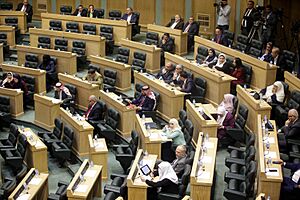
Administrative divisions
Jordan is divided into 12 governorates (muhafazah) informally grouped into three regions: northern, central, southern. The governorates are divided into liwa or districts, which are often further subdivided into qda or sub-districts. Control for each administrative unit is in a "chief town" (administrative centre) known as a nahia.
| Map | Governorate | Capital | Population | ||
|---|---|---|---|---|---|
| Northern region | |||||
| 1 | Irbid | Irbid | 1,770,158 | ||
| 2 | Mafraq | Mafraq | 549,948 | ||
| 3 | Jerash | Jerash | 237,059 | ||
| 4 | Ajloun | Ajloun | 176,080 | ||
| Central region | |||||
| 5 | Amman | Amman | 4,007,256 | ||
| 6 | Zarqa | Zarqa | 1,364,878 | ||
| 7 | Balqa | As-Salt | 491,709 | ||
| 8 | Madaba | Madaba | 189,192 | ||
| Southern region | |||||
| 9 | Karak | Al-Karak | 316,629 | ||
| 10 | Aqaba | Aqaba | 188,160 | ||
| 11 | Ma'an | Ma'an | 144,083 | ||
| 12 | Tafilah | Tafila | 96,291 | ||
Largest cities
The capital city is Amman, located in north-central Jordan.
|
Largest cities or towns in Jordan
According to the 2015 Census |
||
|---|---|---|
| Rank | Name | Pop. |
| 1 | Amman | 1,812,059 |
| 2 | Zarqa | 635,160 |
| 3 | Irbid | 502,714 |
| 4 | Russeifa | 472,604 |
| 5 | Ar-Ramtha | 155,693 |
| 6 | Aqaba | 148,398 |
| 7 | Al-Mafraq | 106,008 |
| 8 | Madaba | 105,353 |
| 9 | As-Salt | 99,890 |
| 10 | Jerash | 50,745 |
Tourism
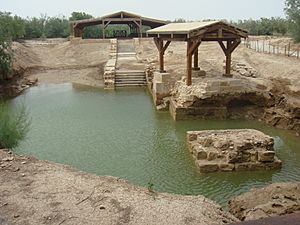
The tourism sector is considered a cornerstone of the economy, being a large source of employment, hard currency and economic growth. In 2010, there were 8 million visitors to Jordan. The majority of tourists coming to Jordan are from European and Arab countries. The tourism sector in Jordan has been severely affected by regional turbulence. The most recent blow to the tourism sector was caused by the Arab Spring, which scared off tourists from the entire region. Jordan experienced a 70% decrease in the number of tourists from 2010 to 2016. Tourist numbers started to recover as of 2017.
According to the Ministry of Tourism and Antiquities, Jordan is home to around 100,000 archaeological and tourist sites. Some very well preserved historical cities include Petra and Jerash, the former being Jordan's most popular tourist attraction and an icon of the kingdom. Jordan is part of the Holy Land and has several biblical attractions that attract pilgrimage activities. Biblical sites include: Al-Maghtas—a traditional location for the Baptism of Jesus, Mount Nebo, Umm ar-Rasas, Madaba and Machaerus.
Islamic sites include shrines of the prophet Muhammad's companions such as 'Abd Allah ibn Rawahah, Zayd ibn Harithah and Muadh ibn Jabal. Ajlun Castle built by Muslim Ayyubid leader Saladin in the 12th century AD during his wars with the Crusaders, is also a popular tourist attraction.
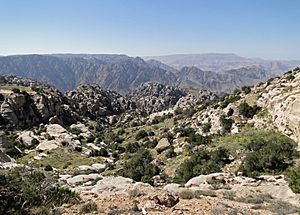
Modern entertainment and recreation in urban areas, mostly in Amman, also attract tourists.
Valleys like Wadi Mujib and hiking trails in different parts of the country attract adventurers. Moreover, seaside recreation is present on the shores of Aqaba and the Dead Sea through several international resorts.
Jordan is the region's top medical tourism destination, as rated by the World Bank, and fifth in the world overall. The majority of patients come from Yemen, Libya and Syria due to the ongoing civil wars in those countries. Jordanian doctors and medical staff have gained experience in dealing with war patients through years of receiving such cases from various conflict zones in the region.
Jordan also is a hub for natural treatment methods in both Ma'in Hot Springs and the Dead Sea. The Dead Sea is often described as a 'natural spa'. It contains 10 times more salt than the average ocean, which makes it impossible to sink in. The high salt concentration of the Dead Sea has been proved as being therapeutic for many skin diseases. The uniqueness of this lake attracts several Jordanian and foreign vacationers, which boosted investments in the hotel sector in the area.
The Jordan Trail, a 650 km (400 mi) hiking trail stretching the entire country from north to south, crossing several of Jordan's attractions was established in 2015. The trail aims to revive the Jordanian tourism sector.
Culture
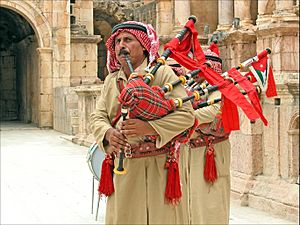
Many institutions in Jordan aim to increase cultural awareness of Jordanian Art and to represent Jordan's artistic movements in fields such as paintings, sculpture, graffiti and photography. The art scene has been developing in the past few years and Jordan has been a haven for artists from surrounding countries. In January 2016, for the first time ever, a Jordanian film called Theeb was nominated for the Academy Awards for Best Foreign Language Film.
The largest museum in Jordan is The Jordan Museum. It contains much of the valuable archaeological findings in the country, including some of the Dead Sea Scrolls, the Neolithic limestone statues of 'Ain Ghazal and a copy of the Mesha Stele. Most museums in Jordan are located in Amman including The Children's Museum Jordan, The Martyr's Memorial and Museum and the Royal Automobile Museum. Museums outside Amman include the Aqaba Archaeological Museum. The Jordan National Gallery of Fine Arts is a major contemporary art museum located in Amman.
Music in Jordan is now developing with a lot of new bands and artists, who are now popular in the Middle East. The Jerash Festival is an annual music event that features popular Arab singers. Pianist and composer Zade Dirani has gained wide international popularity. There is also an increasing growth of alternative Arabic rock bands, who are dominating the scene in the Arab World.
Cuisine
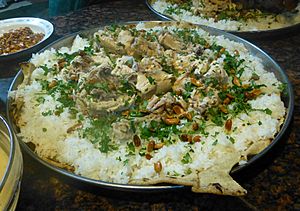
As the 8th largest producer of olives in the world, olive oil is the main cooking oil in Jordan. A common appetizer is hummus, which is a puree of chick peas blended with tahini, lemon, and garlic. Ful medames is another well-known appetiser. A typical worker's meal, it has since made its way to the tables of the upper class. A typical Jordanian meze often contains koubba maqliya, labaneh, baba ghanoush, tabbouleh, olives and pickles.
Meze is generally accompanied by the Levantine alcoholic drink arak, which is made from grapes and aniseed and is similar to ouzo, rakı and pastis. Jordanian wine and beer are also sometimes used. The same dishes, served without alcoholic drinks, can also be termed "muqabbilat" (starters) in Arabic.
The most distinctive Jordanian dish is mansaf, the national dish of Jordan. The dish is a symbol for Jordanian hospitality and is influenced by the Bedouin culture. Mansaf is eaten on different occasions such as funerals, weddings and on religious holidays. It consists of a plate of rice with meat that was boiled in thick yogurt, sprayed with pine nuts and sometimes herbs. As an old tradition, the dish is eaten using one's hands.
Simple fresh fruit is often served towards the end of a Jordanian meal, but there is also dessert, such as baklava, hareeseh, knafeh, halva and qatayef, a dish made specially for Ramadan. In Jordanian cuisine, drinking coffee and tea flavoured with na'na or meramiyyeh is almost a ritual.
Related pages
Images for kids
-
The Mesha Stele (c. 840 BC) records the glory of Mesha, King of Moab
-
Al-Khazneh in Petra (c. 1st century AD), is believed to be the mausoleum of the Arab Nabataean King Aretas IV.
-
The earliest detailed map of the land which became Jordan, showing the travels of Johann Ludwig Burckhardt (the first European to see Petra since the Crusades) in 1822
-
Soldiers of the Hashemite-led Arab Army holding the flag of the Great Arab Revolt in 1916
-
Al-Salt residents gather on 20 August 1920 during the British High Commissioner's visit to Transjordan.
-
King Abdullah I on 25 May 1946 reading the declaration of independence.
-
King Hussein on 21 March 1968 checking an abandoned Israeli tank in the aftermath of the Battle of Karameh.
-
Wadi Rum's resemblance to the surface of Mars has made it a popular filming and tourist attraction.
-
Queen Alia International Airport near Amman was chosen as the best airport in the Middle East for 2014 and 2015 by ASQ.
-
The Aqaba Flagpole in the southernmost city of Aqaba, Jordan's only coastal outlet
-
An aerial view of a portion of the Zaatari refugee camp which contains a population of 80,000 Syrian refugees, the largest Syrian refugee camp in the world.
See also
 In Spanish: Jordania para niños
In Spanish: Jordania para niños




